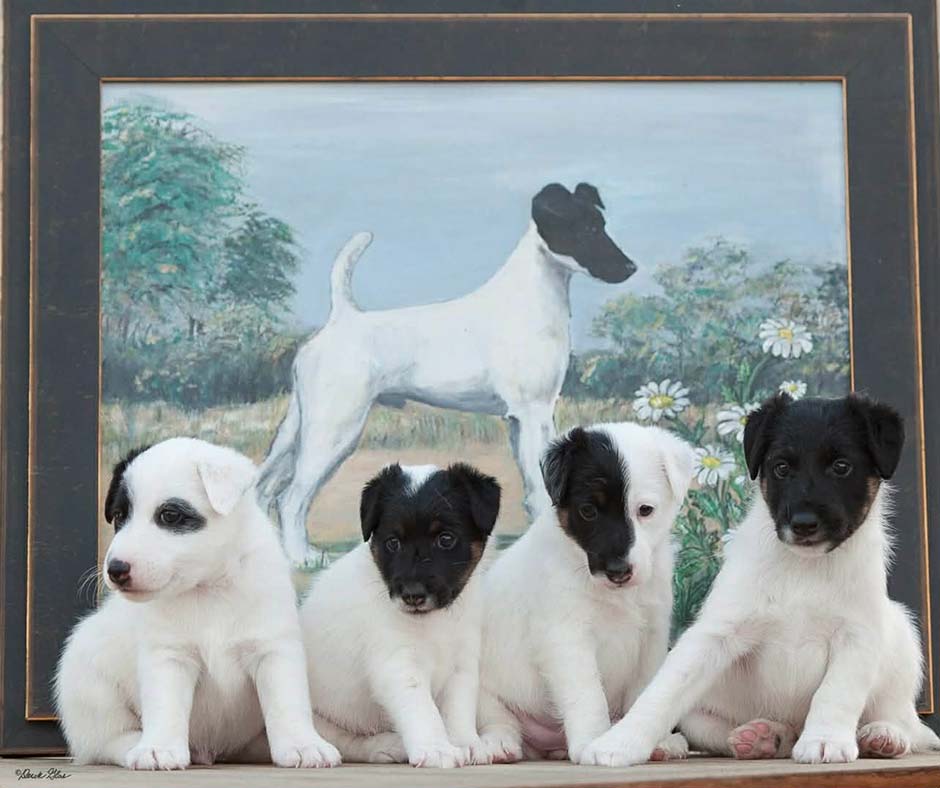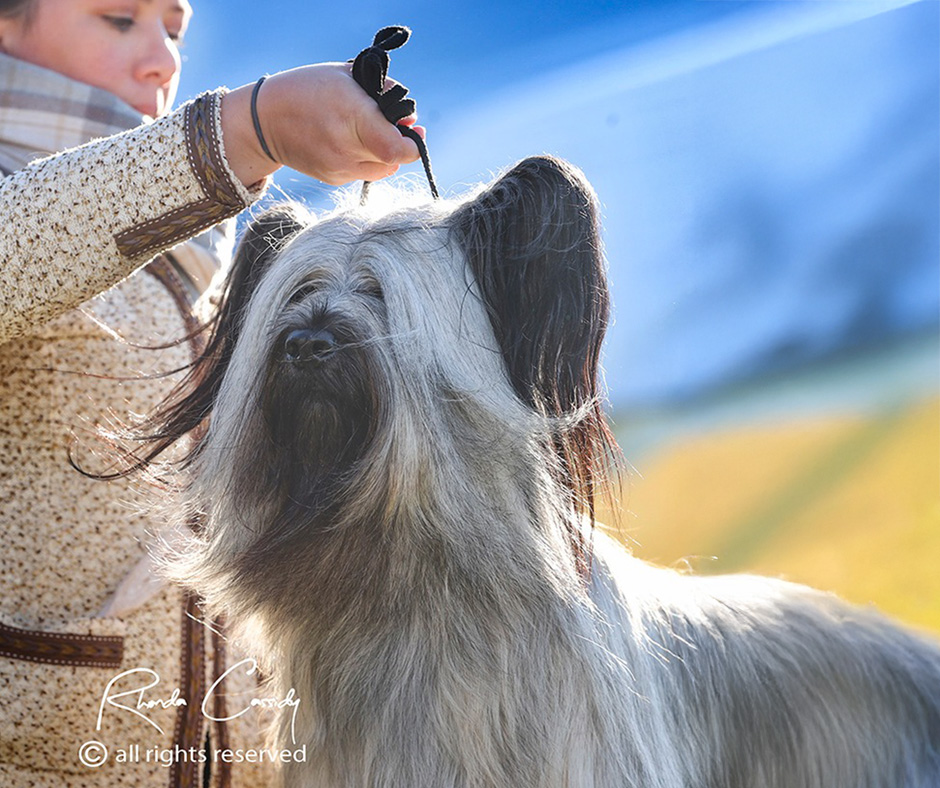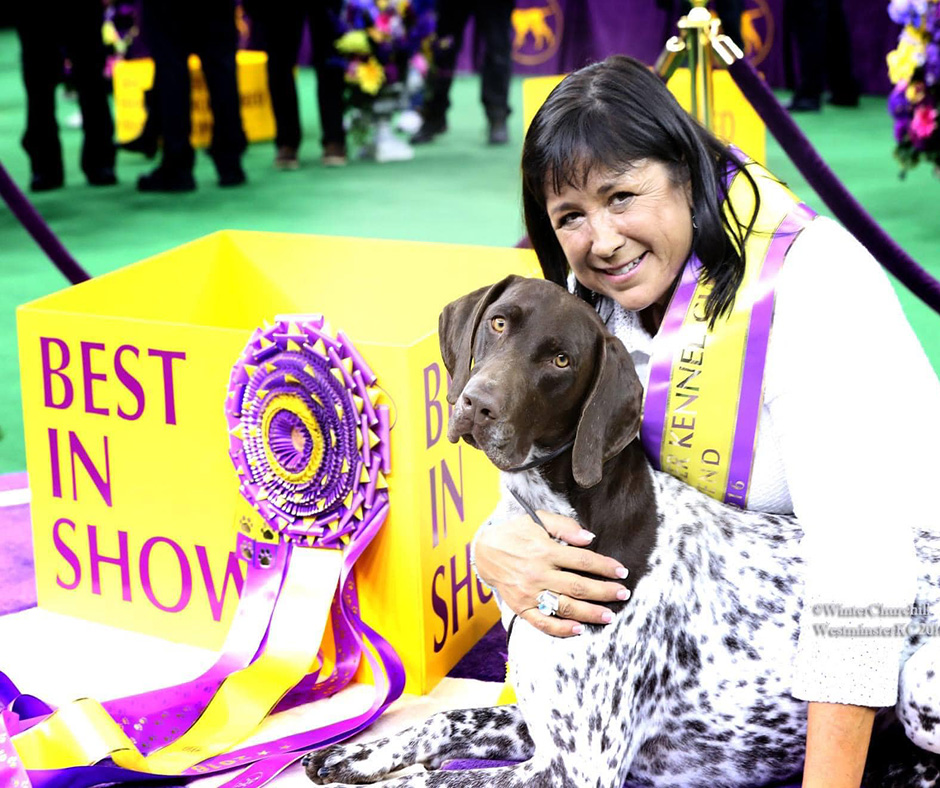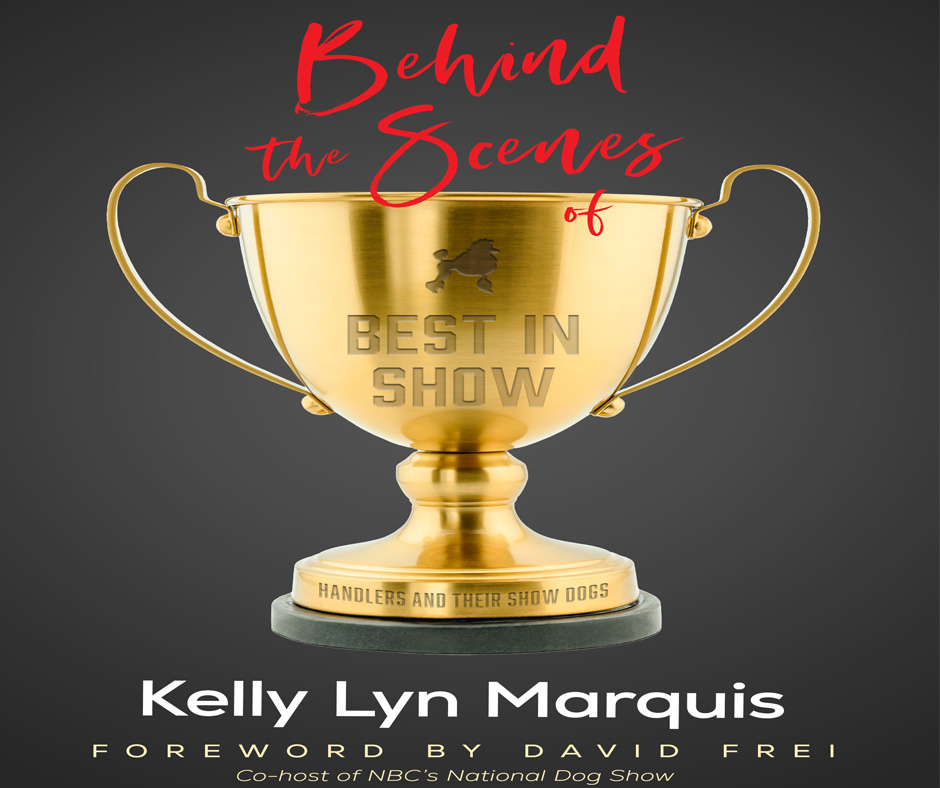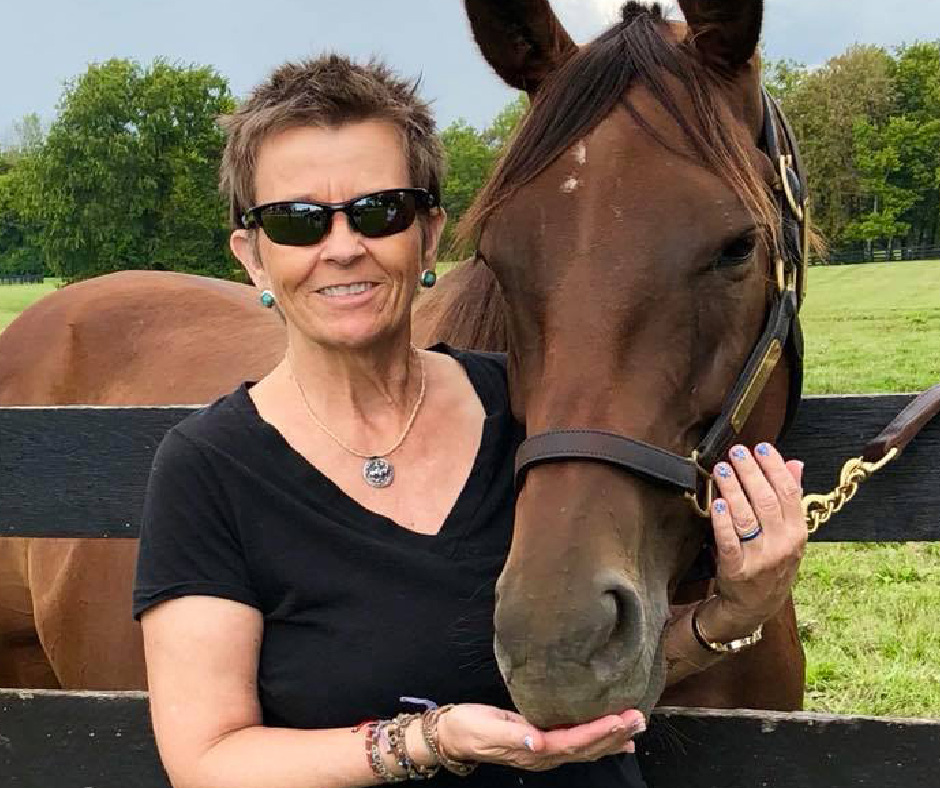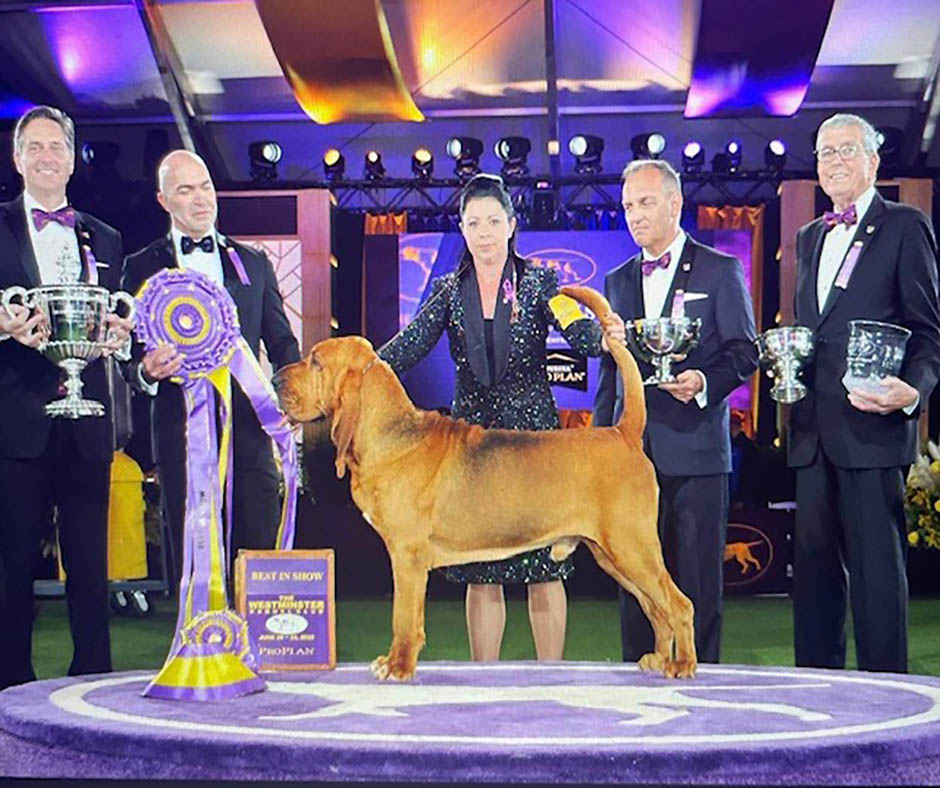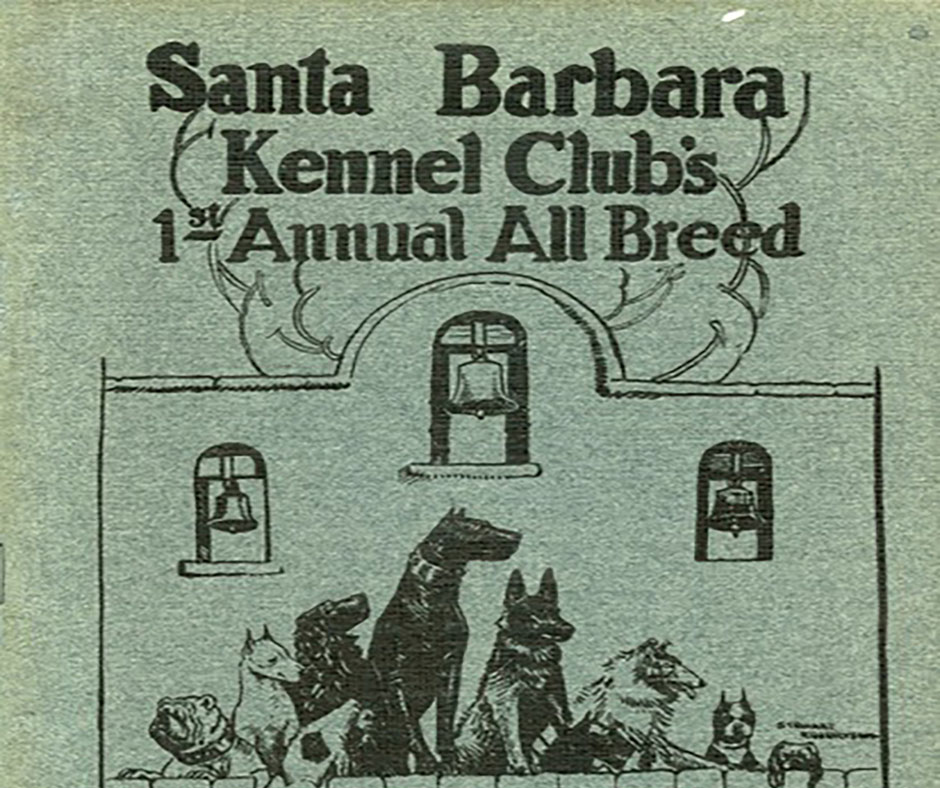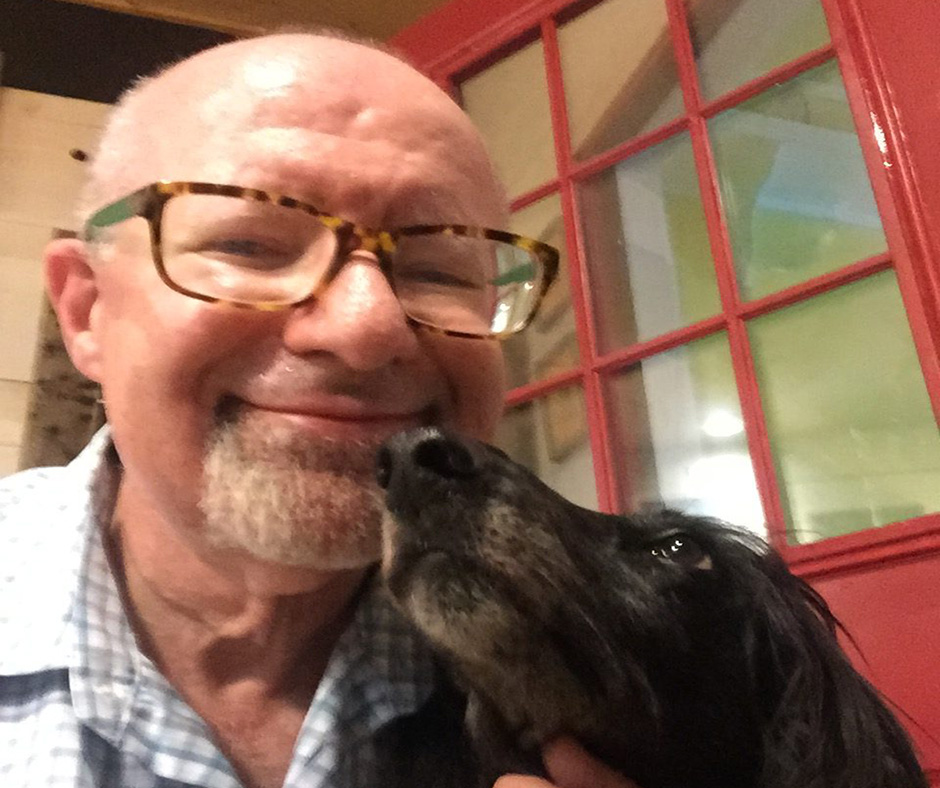719 — Amy Rutherford on Smooths, Bred-By Success and Preservation Breeding
Amy Rutherford on Smooths, Bred-By Success and Preservation Breeding
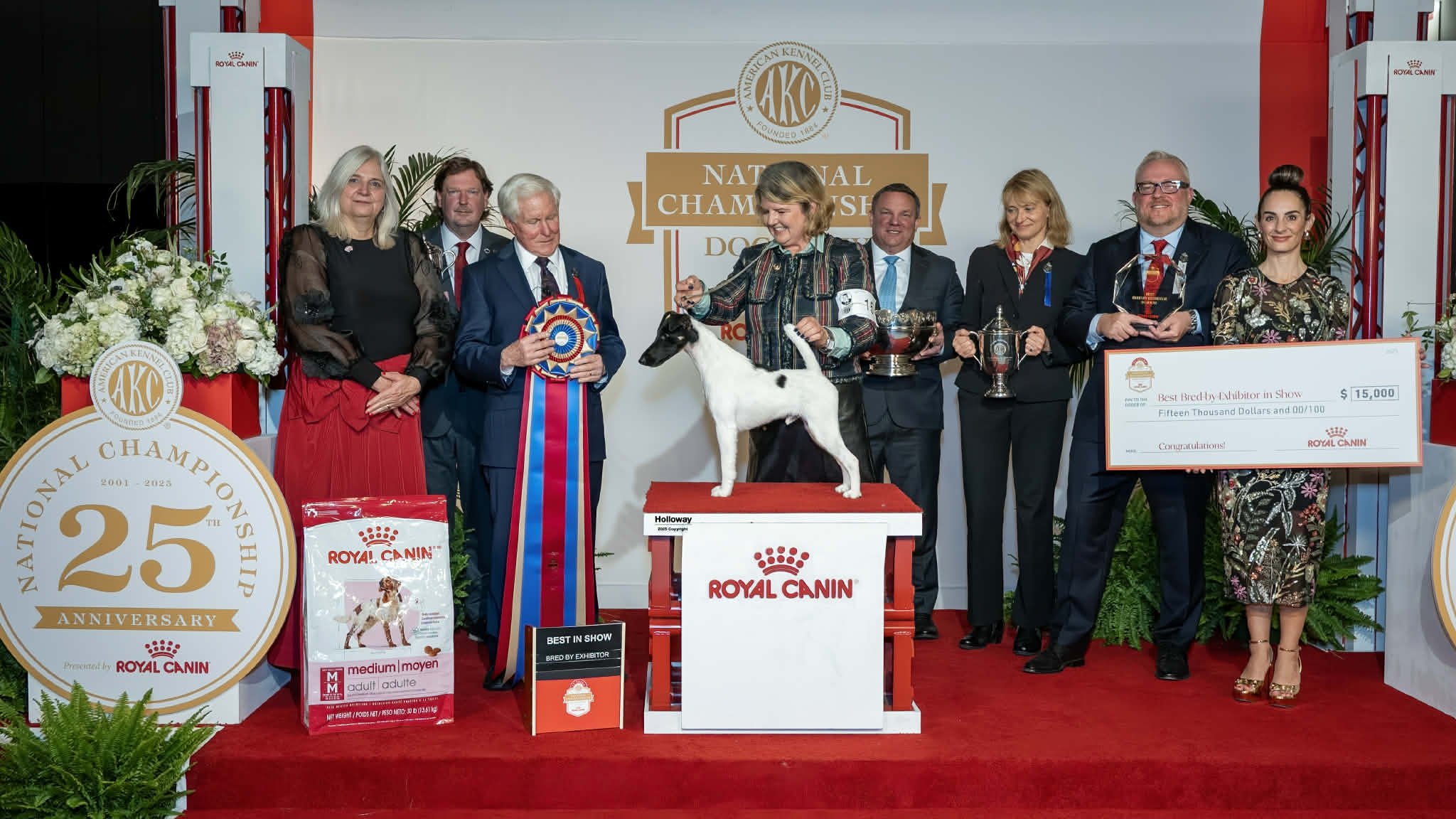
Amy Rutherford winning Best Bred By Exhibitor at AKC National Championship with Wager.
Today’s episode brings you a rare conversation with someone who does not say yes to interviews very often. Amy Rutherford joined host Laura Reeves for a holiday visit and the timing could not be better, fresh off her Best Bred-By Exhibitor win at the AKC National Championship with her Smooth Fox Terrier, Wager. For breeders, exhibitors, and dog show fans, this conversation delivers real insight into what it takes to build a program that lasts.
From a childhood dog show moment to a lifetime in terriers
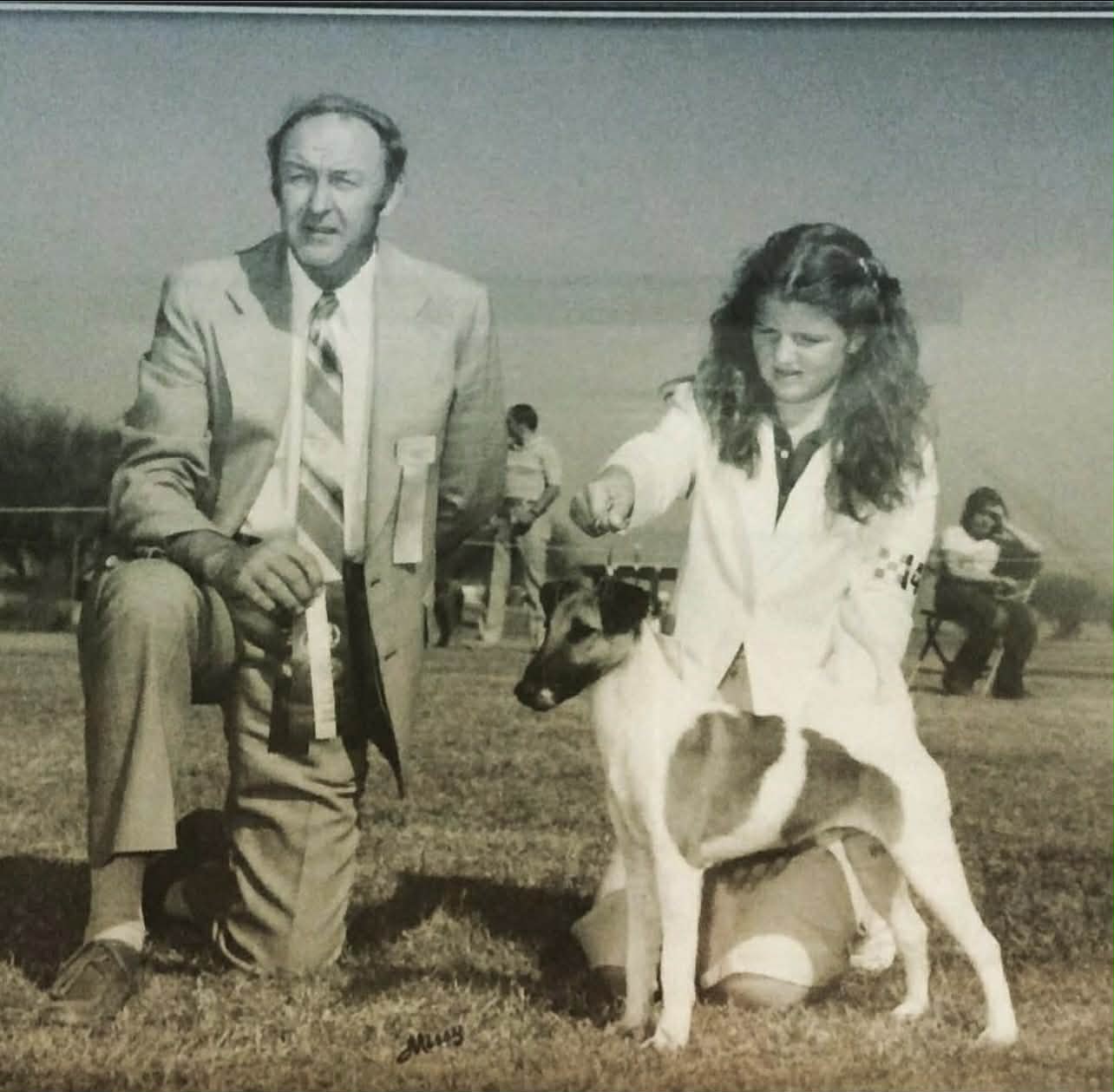
Rutherford with one of her foundation Smooth Fox Terriers.
Amy’s path started early. Her parents were horse people who also kept Australian Shepherds before they were AKC recognized. A winter trip turned into a defining moment when the family got snowed in and visited an AKC dog show. From the stands, young Amy watched Smooth Fox Terriers in the ring and knew she wanted that life.
The journey was not immediate. Her first breed was Airedales, which taught hard lessons about grooming, structure, and realistic expectations. Eventually, she saved money and purchased Smooth Fox Terrier puppies that both finished quickly and became group winners. That early success did more than build confidence. It created a foundation and one of those early bitches still anchors the pedigree behind her dogs today.
The handler apprenticeship that built a career
Amy’s handling career developed the way the best ones often do, through years of real work. She spent summers helping professionals and then committed to a full apprenticeship with Eddie and Leslie Boyes. She stayed for nine years, learning the daily realities of conditioning, presentation, animal husbandry, trimming and the logistics that define show life.
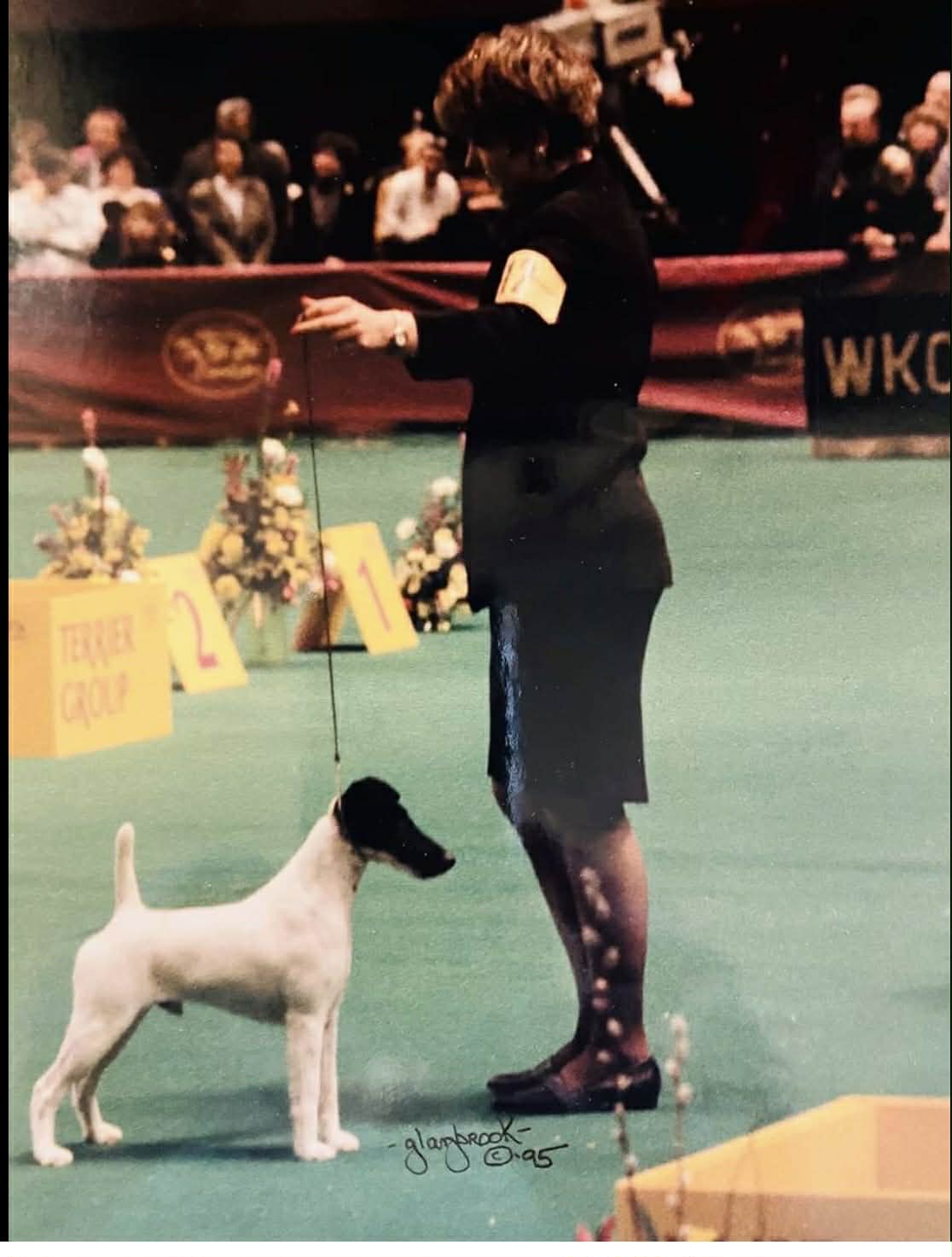
Rutherford showing Dover, Ch. Aimhi Type Cast, at Westminster Kennel Club.
That apprenticeship is a major takeaway for anyone interested in becoming a professional handler. Amy explains that experience builds skill and it builds a network. When she went out on her own, she had the credibility and connections that make the difference between surviving and thriving.
Showing different breeds and winning with controversial dogs
One of the most valuable parts of this episode is Amy’s honest discussion about stepping into breeds that are not part of your original comfort zone. She moved from Smooth Fox
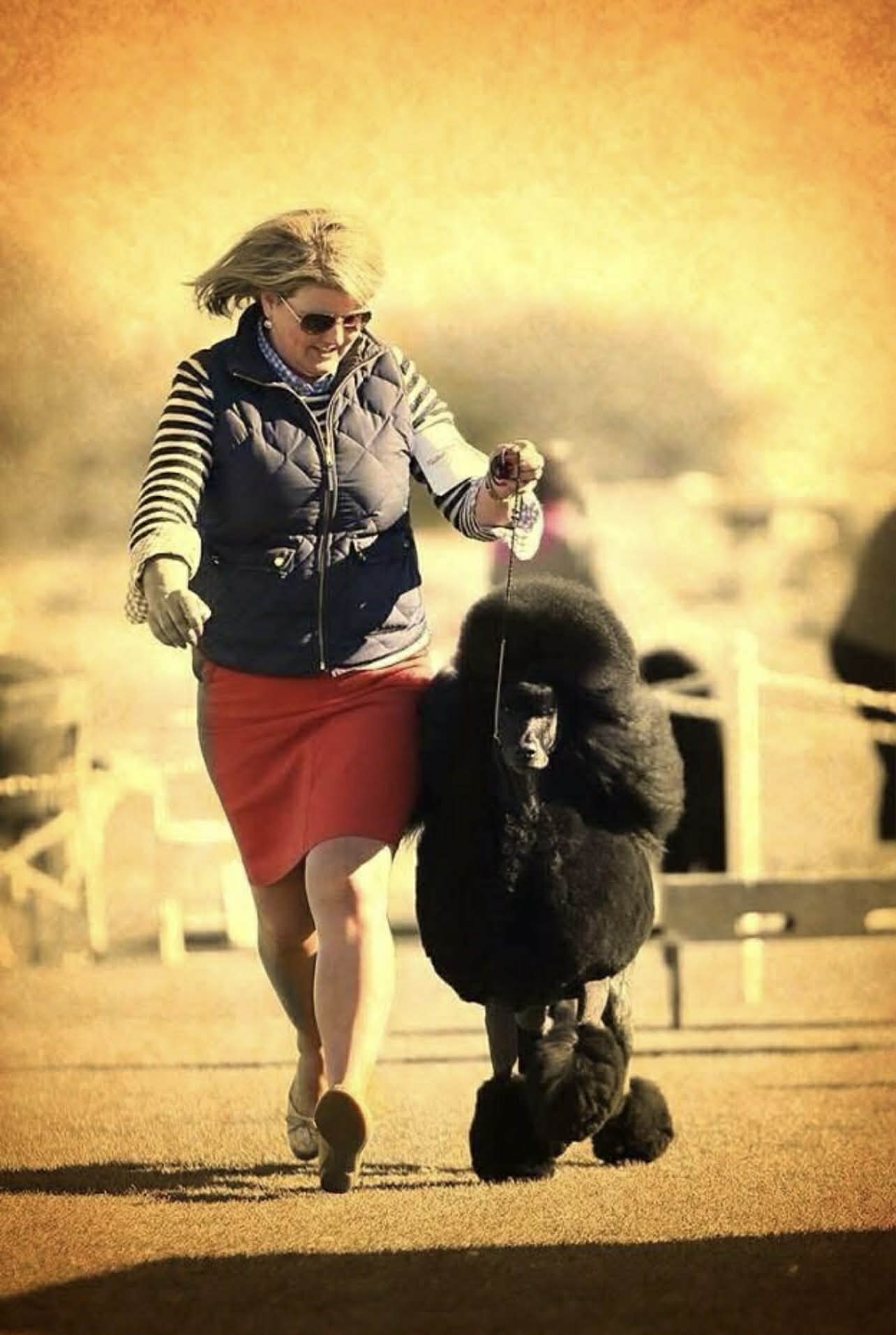
Rutherford showing Standard Poodle, Dino, GCH. Del Zarzoso Salvame From Afterglow
Terriers into coated breeds including a Portugese Water Dog and a Standard Poodle import. Her advice is clear. Learn from the best people you can find, ask for feedback, and keep training your eye.
She also talks about the reality of showing a dog that does not match the popular look of the moment. Her Standard Poodle, Dino, was impressive and successful but also controversial. Amy says the key is believing in your dog completely and choosing shows and judges who will appreciate the dog’s strengths.
Building a Smooth Fox Terrier program that produces winners
For preservation breeders, Amy’s success with Smooth Fox Terriers offers powerful lessons. She describes how she pursued the look she wanted, sought mentorship and bred to the best dogs available. The results include legendary dogs like Dover, a top-winning Smooth Fox Terrier who also became a major sire.
That legacy continues with Wager, the dog who earned Best Bred-By Exhibitor at the AKC National Championship. Amy shares the behind the scenes breeding decisions, the role of frozen semen and a few “miracle” moments that made Wager possible.
If you are serious about showing dogs, preservation breeding, or building a kennel name with meaning, this episode is required listening. Learn more and listen now at PureDogTalk.com.
669 – How to Climb the Mountain to Owner Handled Success
How to Climb the Mountain to Owner Handled Success
Antoinelle Vulpis joins host Laura Reeves to discuss how she climbed to the pinnacle of owner handled success, winning Best in Show at Montgomery Kennel Club with her Skye Terrier.
Vulpis discussed the beginning of this journey in an episode with Laura five years ago. Today’s conversation brings the story full circle.
“After our big win at Kennel Club of Philadelphia, I was thinking, we got some awesome momentum,” Vulpis said. “We got two more best in show after I spoke with you. I was like, this is incredible. And then the pandemic hit, so all that momentum and excitement just went away for me. For everyone, you know, it was just kind of a weird time. And then when we were lucky enough to have shows again, trying to pick that back up and make people believe again is kind of tough. So it was a little of a unique experience in that.
“Then (I) realiz(ed) that I have these goals in mind, just these little things that I want to check off my checklist. I want to show him at my national. As a veteran. That was a goal of mine and that’s what our whole plan was to do. And then I went to Canada too. I was like, let me get his Canadian Championship. Go to Canada with my girlfriends, have a girls weekend and try to get a title. So yeah, I literally only showed him in June (2024) to finish his Canadian title and then Montgomery.
…if the judge can’t see it, it doesn’t matter…
“(In Best in Show) we’re showing to Lydia Coleman Hutchinson, the legend. I’ve shown to her several times throughout my dog’s career, maybe half a dozen times. But just to be in the ring and like to put my dog on the table as you know, a 7 1/2 year old dog, like just knowing that she’s seen him as a puppy, it was very emotional for me and I just kept on being like ‘Don’t cry. Don’t cry.’
“It’s just such a full circle moment. And I felt so fortunate to just be in her ring again at this stage because this is going to be my last time showing him at the National.
“(On his down and back) I took a knee, man. I mean, it was my Hail Mary. It was the last move, the last card that I had in my deck. So I just got down and just tried to manipulate the lead a little bit and to get him to react to me. And just to see like, ohh, mom is eye level, that kind of thing. And so if you get that, you can get the ears to react a little bit and just let him show off that beautiful top line and his long neck. So you just want him to just for a brief second show off these qualities that we know he has. But you know the answer right? I know my dog has it, but if the judge can’t see it, it doesn’t matter.”
To hear all of Vulpis’ tips and tricks, listen in to the podcast today…
633 – The New Voice of Westminster Kennel Club
The New Voice of Westminster Kennel Club
Host Laura Reeves is joined by Valerie Nunes-Atkinson, handler, breeder and the new color commentator at Westminster Kennel Club.
“So I think one of the reasons why I’ve been brought in is because of some of the things that you mentioned, being a handler, having lived it and been there. So I’m hoping to bring the insight from that perspective, from the handler’s perspective, the excitement of it, what goes on a little bit behind the scenes, but then also from a breeder perspective, you know, having bred dogs that have done well there and bred dogs for decades.
“Jason has been a breeder and a handler and a judge, but he’s more from the judge’s perspective and the historical importance of the breeds and details of the breeds. And I hope to bring a little bit of the other type of knowledge. And Chris is our fun guy that asks interesting questions.
“You learn how to listen to someone in your ears and still talk… It’s something, I will say it’s something to get used to. So they’re talking in your ear. ear and they’re counting you down. So literally we have about 20 seconds after the announcer gives all the breed details on that particular breed to make a point about something and keep it somewhat interesting.
“Twenty seconds is a long time, but it’s really not a long time. So to be concise and get your message across and be done before he starts going into the next breed. So they’re counting you down as you’re talking and trying to make your point in these 20 seconds and you have to be done by the time they get to one. Otherwise, someone might be screaming in your ear.
“So learning that and learning how to go back and forth between the three of us and not step on each other, so that you’re not talking over the other person.
“There’s a huge learning curve and we’ll see because, you know, it basically scares the, you know, what out of me to be doing this. And I really considered not doing it. But my dad always told me, and this was before he passed, he said, ‘If you’re not doing something that is scary and challenges you and really scares you, you’re not growing.’ So you’ve got to live your life. You’ve got to push yourself and reach for other goals. And so I’m doing it.
“And that’s where I think, you know, through this broadcast and through Jason and Chris, I mean, we hope to, you know, give breed details. We hope to give breed information to the general public. That’ll be interesting that maybe allows them to think about other breeds and hopefully maybe even learn how to find a preservation breeder.
“I think being able to, for my role, step in and maybe tell some little tidbits of stories or experiences that I’ve had that might bring other people in to say, ‘Hey, maybe I could try that or that sounds fun.’ Or maybe they don’t even know about things we’re talking about like the agility. trial that’s gonna be there as well. There’s other sports within AKC that the general public can do wth their dogs, which is very exciting. And I think it’s a way to bring everybody else, the general public into a scene, what else you can do with your dogs?”
626 – Kelly Lyn Marquis Shares Her Insights from the Masters
Kelly Lyn Marquis Shares Her Insights from the Masters
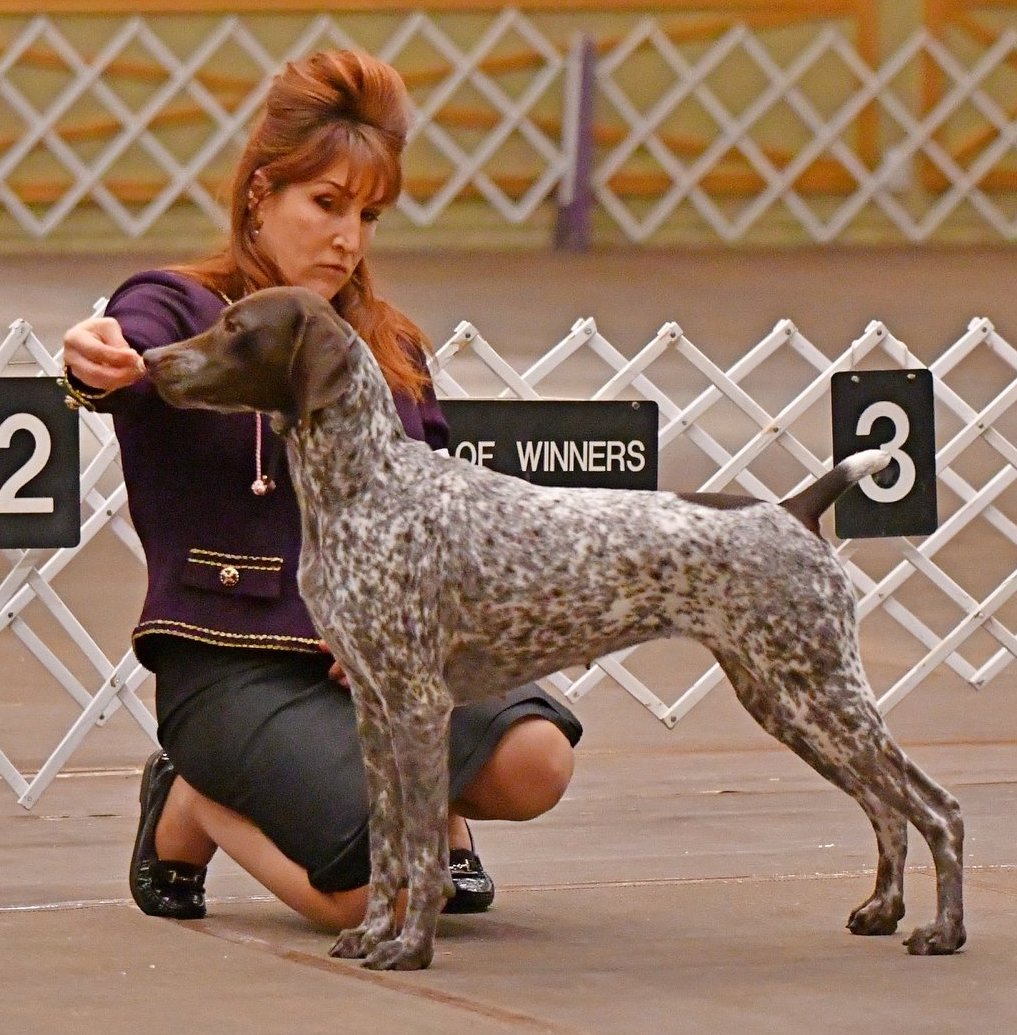
Kelly Lyn Marquis in the ring.
Host Laura Reeves is joined by Kelly Lyn Marquis to discuss the stories in Marquis’ new book Behind the Scenes of Best in Show: Intimate Moments with the Masters.
“When I started writing (the book),” Marquis said, “I was seeing some dissension, sometimes some frustration where I would hear people saying things about handlers doing all the winning and you know I really really wanted to show all of the work that goes into those wins.
“And even even for many of us that you see in the book, for so many of the masters, it’s not about the wins. Actually, not one of them, not one of them, mentioned about the win being something that matters to them. It’s the behind the scenes things that matter to them whether it’s making their clients happy or the connection that they have with that dog. And that was a motivation.
In her conversation with Michael Scott, Marquis admits struggling to understand his thinking.
“…(T)o Michael, it is his job to handle the dog to the (best of his) ability and to bring that dog to the right judges. And he knows his judges well. He knows what they like, as did Gwen (DeMilta). (B)ut Michael’s job was to handle. Well, there wasn’t the messiness that I would see in Gwen, and that also was active in myself as well.
“So when I interviewed Michael and Michael said, ‘My job is to handle the dog and to bring it to the right judges. Period.’ And he even went on to say that, ‘Look, it’s a game.’ And that really triggered me ’cause I thought, ‘No, this is serious business!’ And it isn’t that Michael doesn’t take it seriously, but he’s very clear on what his role is as a handler.
“That was one of the things that really struck me interviewing Michael, was if Michael had been my mentor and if I operated and navigated the dog show world with Michael’s mindset, how might my… my life be different? So that is one of the values that I think a reader can get from reading this book where when you see where someone’s priorities are and how that shapes how they navigate the world…
“When it comes to the passion and the emotional attachment, I always give credit to the owner handlers and let them know that when it comes to my own dog, I have to have another handler show it because it gets messy.
“One of the things that I love about handlers that I think is a lesson for, well, even for ourselves to bring out into the world, but we’re masters of our emotion. It’s like you, okay, we look at this, what do I need to be? How do I need to show up for this dog?
“And we’re very clear about that. We have a very clear role and we’re able to be in integrity and we’re also able to look at that dog and go, okay, what’s going on with you? You and I, we need to… make this work. We don’t have the luxury to have an emotional moment,
“Which also gets me thinking about another motivation for my book. I wanted to show our humanity because when we’re at a dog show, we need to be in business mode. We’re not showing our… our feelings.
“You know, Michelle Scott talks about how difficult it can be for her at times, managing her expectations and how she knows she wants to make people happy. And it can be so disappointing when you’re not able to make that person happy. But we can’t show that we have to show up and we have to be professionals. But it doesn’t mean that we don’t feel things. It just means that we’re in business mode, we can’t be getting caught up in those places, but we do have feelings just like everyone else.
“Another motivating factor for me is this is our community. I’m looking around it it’s scary it looks like a dying community. I believe that this is an underlying theme in my book as well is that we are people. There are people at the ends of those leads and we need to be taking care of ourselves and our community better. One of the things that I’ve learned. Being a mom is my number one priority. And if my work is getting me so strung out that when my daughter comes home from school I can’t hold space for that because I’m too agitated myself, then I’m not able to be the mom that I want to be. And so even as handlers, when we show up at our job, are we making good choices for ourselves so that we can serve not only ourselves but more people?”
617 – Breed Type First: Mary Dukes on Judging Dogs
Breed Type First: Mary Dukes on Judging Dogs
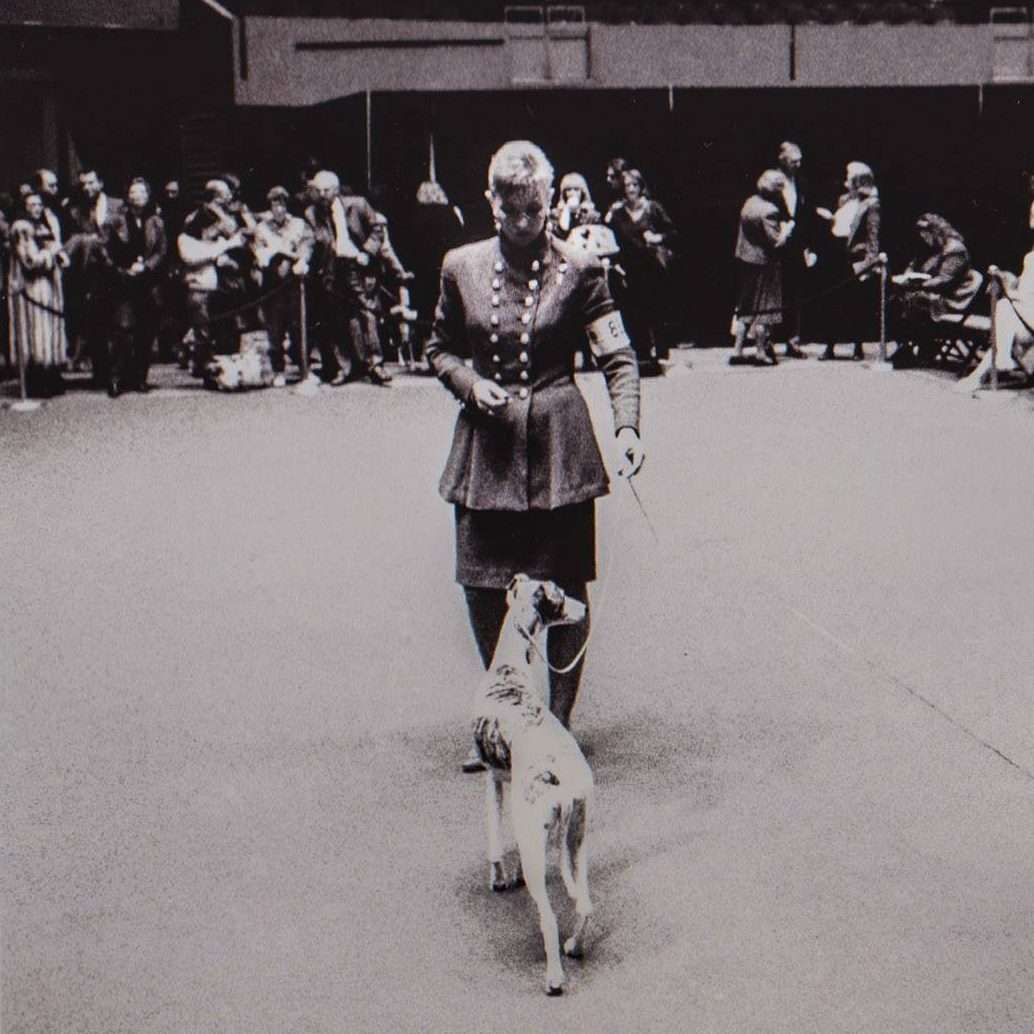
Mary Dukes in her handling days heyday.
Legendary handler, rep and now judge Mary Dukes continues her conversation with host Laura Reeves. Today they talk about judging, handling and all-time favorite dogs.
“I’m a type-first girl all the way,” Dukes said, quoting the notable Anne Rogers Clark common wisdom to sort first on type and then reward the soundest of the typical dogs. “I’m forgiving of leg faults, especially on the down and back. As long as it doesn’t offend me, it’s probably good enough.
“I do firmly believe this. A good judge can see right through a poor handling job. Sometimes it’s frustrating. I watched a breed in Orlando. It wasn’t a hound breed but a breed that I’m very familiar with and it was so frustrating because it’s an owner -handled breed for the most part and the best dogs in there were being tragically handled. It was so frustrating because there was a dog in there that’s beautiful and every time the judge looked at him (the handler) wasn’t even trying to do anything with him. His legs were everywhere. You know, all she was doing was feeding him basically.
“And I thought, God, if you could just rack him up once, just rack him up once and pull him up over his front and break him over, (the judge) just needs to see it once.
“I might be the one that will turn into Frank Sabella. I mean, not in terms of swapping dogs or anything, because he did that to me a million times, but I know he got in trouble for it. But in terms of, ‘Here’s what I want you to do. Can you go from this corner to that corner on a loose lead? Can you do that?’ If they give me five steps, we’re golden.
“At the end of the day, it’s putting up the best dog.”
Pro tip: Pacing
“It’s all about throwing them off balance when you take the first step. I always like to go into them because they learn pretty quick. A lot of people they jerk (the dog) and then ‘let’s go.’ Well, then the dog starts anticipating that. I just would turn them into me and then just bump them. Just bump their shoulder as you start your down and back.”
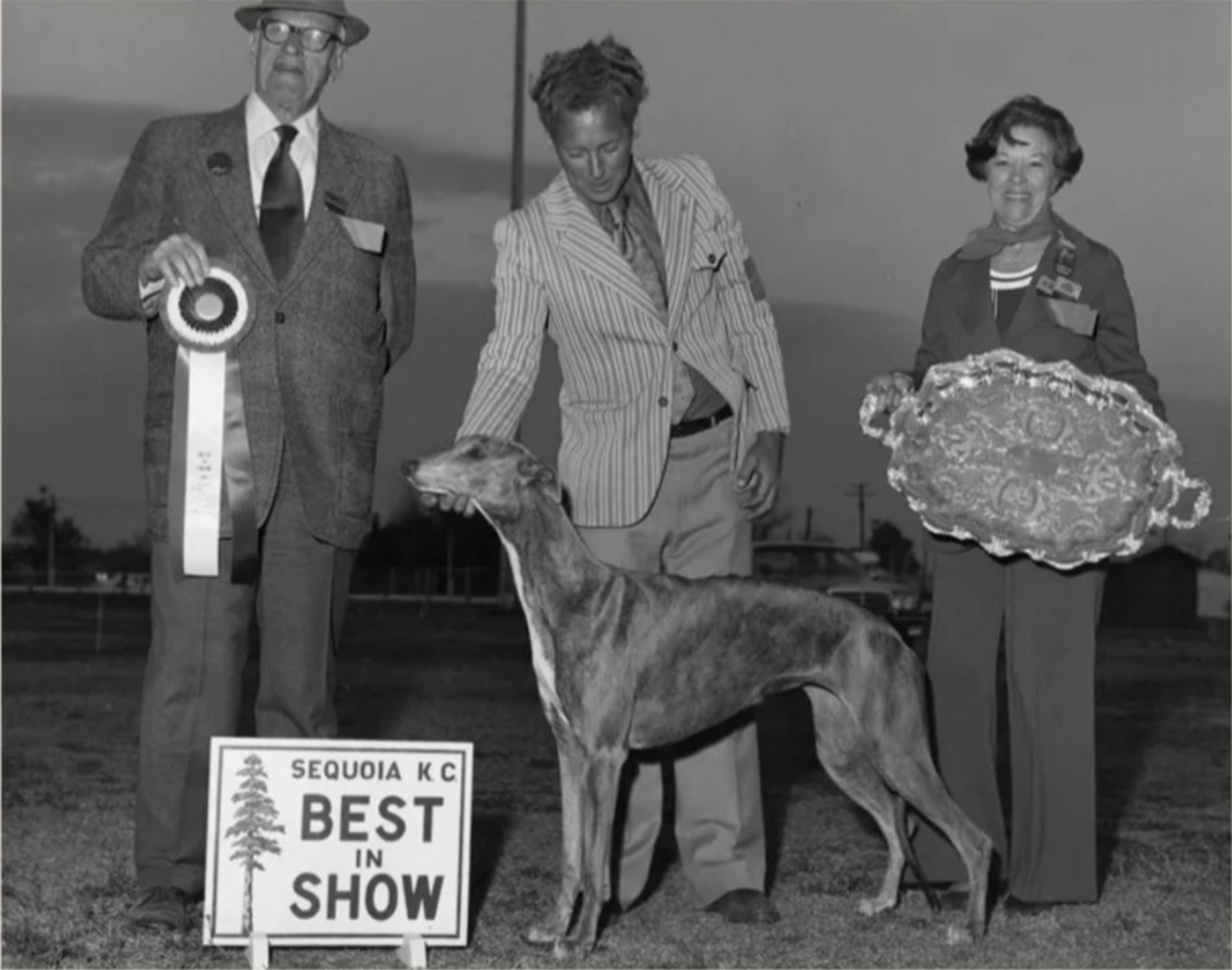
Ch. Aroi Talk of the Blues, ‘Punky’, shown with handler Corky Vroom. Judge Anne Rogers Clark “discovered” Punky in 1975, when she made her Best of Breed from the Puppy class at the Greyhound Club of America specialty in Santa Barbara. Punky was the Top Dog of all breeds in 1976.
Mary’s fantasy best in show line up would be judged by Michelle Billings. It would feature Mick, the Kerry Blue who shows up in most judges’ all-time best line ups, but many of her other choices are more esoteric and focused on dogs she knew personally. From Iron Eyes, the Bouvier to Scarlett Ribbons, the Italian Greyhound. Listen in to hear her personal choice for Best in Show.
539 – Dr. Donald Sturz, Dog Show Philosopher & WKC BIS Judge
Dr. Donald Sturz, Dog Show Philosopher & WKC BIS Judge
 Dr. Donald Sturz, 2022 BIS judge at Westminster Kennel Club, joins host Laura Reeves to talk purebred dogs as history and art. And goosebumps at seven contenders in a unique and powerful lineup.
Dr. Donald Sturz, 2022 BIS judge at Westminster Kennel Club, joins host Laura Reeves to talk purebred dogs as history and art. And goosebumps at seven contenders in a unique and powerful lineup.
“From a historical perspective,” Sturz said, “I think it’s so important that we keep our focus on the history of particular breeds, not just from the point of view of the climate or where they came from, the terrain that they worked on or jobs that would to do, but also how the breed has evolved over time and understanding the difference between the evolution of a breed versus the changing of a breed.
“I think those are two very different things and so I think having a historical perspective, I was gonna say as a judge, but also as a breeder, I think that that informs your decisions, it informs your perception of the dogs that you’re looking at when you put them in that historical context of both where they originated, but what they were meant to do and how they’ve evolved over time.
Purebred dogs are history and they are art
 “When you talk about dogs as art, that really resonates with me, because that’s what it’s like to me when I go to a dog show. I look at dogs as I would look at art in a museum. I love when something moves me. You know how when you look at a beautiful piece of art, whether it’s a painting or sculpture or whatever, and you just have a visceral emotional reaction. I love when that happens for me with a dog. As a judge it doesn’t happen all the time, it doesn’t happen as frequently as one might like, but when it does happen, it’s kind of like the reinforcer.
“When you talk about dogs as art, that really resonates with me, because that’s what it’s like to me when I go to a dog show. I look at dogs as I would look at art in a museum. I love when something moves me. You know how when you look at a beautiful piece of art, whether it’s a painting or sculpture or whatever, and you just have a visceral emotional reaction. I love when that happens for me with a dog. As a judge it doesn’t happen all the time, it doesn’t happen as frequently as one might like, but when it does happen, it’s kind of like the reinforcer.
Patience is a virtue
“People have gotten so caught up in immediate gratification and looking for the outcome rather than the process. I think it’s important for us, especially in dogs, to kind of catch ourselves. If we find ourselves in that kind of moment, I’ll say wait a minute, slowdown skippy, you know there’s a bigger picture and a much longer story and you need to keep reminding yourself of that.
“I’m big on there being gray areas. I can allow for some stylistic differences on the continuum. But there’s a point, there’s a line where you get, that’s too much, that’s too far. It’s either too moderate or too extreme. I have a little wiggle room on both sides of that, so that’s how I would process kind of that global perspective piece.
“Being able to kind of see the forest for the trees and be able to, as a breeder, see how that dog can add to your journey as you pursue your vision of the breed. I think also being able to think in a more long-term way.
“I think the mistake, unfortunately, is people are like ‘oh, I’m gonna breed to this dog from wherever and I’m gonna bring in these qualities’ and then they have a litter and it’s like ‘oh I didn’t get what I wanted.’ You’re probably not gonna get what you want. You have to keep working and building and choosing and selecting. It’s a longer term process when one tries to do something like that. Does it sometimes click? Yeah, it sometimes happens. But I think that’s unusual. You have to kind of make a commitment to a few generations out, at least, to see what you were trying to get to.
Deciding in the moment
“What was so beautiful was that his breeder owner handler just very calmly stepped out there and guided him very deftly into a natural stance. He just planted his four feet perfectly without any the crossover thing … it was just boom boom boom. And then he just stood there and he literally stared at me. I’m like ‘Oh my God this is a really proud dog. This is a dog who’s giving me a dog standing over a lot of ground, a dog of power and strength. And then I sent him around and his gait was just flawless… Powerful and covering ground and elasticity. Head and tail carriage… and it was perfection to me. In that moment, it was like ‘there it is.’”
512 – No Best in Show? Looking Back with Bo Bengtson
No Best in Show? Looking Back with Bo Bengtson
Author, historian, editor and Sighthound specialist Bo Bengtson joins host Laura Reeves again for a fascinating look back at dog shows *before* Best in Show.
“You gotta go several thousand years back basically,” Bengtson said of people appreciating the beauty of dogs. “Even in the Odyssey, which is Homer 2,000 years ago, there is a reference that cited the people who own dogs because they’re handsome, because they look good.
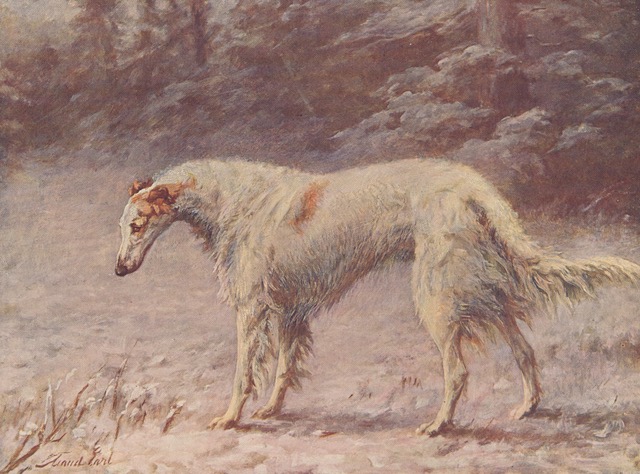
Sighthounds were a favorite subject of artists through the centuries, including this stunning Maude Earl Borzoi canvas.
“That’s kind of really interesting to me that even in those days people cared about what dogs look like. Going through the Middle Ages and forward, you find several references to not just hunting dogs or war dogs or something, but also to luxury dogs or pets. Greyhounds of all types are very, very frequently portrayed.
“And then we get up to the 1800s and middle of 1800s and the industrial revolution in England. Suddenly, there was a whole new class created by the industrial revolution. People who had money and had time on their hands and what could they better focus on than dogs. That was very interesting to them and that’s where the beginning of the modern dog sport really stands.
“The dog shows of the past were not at all like modern dog shows. There was often a best in show award but even defeated dogs could actually compete for it. There were no groups and there were not even necessarily breeds.
“In 1924, the American Kennel Club introduced new regulations and since then it’s basically been (the same). The number of groups has increased slightly and the number of breeds increased drastically, but their regulations for competing have remained unchanged.
“Even in my early days, in the 1980s in this country, there was not even necessarily Best in Show. I remember very, very vividly that I had a group winner who was not allowed to compete for Best in Show because there wasn’t a Best in Show at that show. In the beginning, only half the number of shows had the best in show award … eventually that grew up to present day.
“There have always been people who are nuts about competing for best in show and campaigning dogs. I mean you don’t think of people in the ‘30s or ‘40s or something that is campaigning dogs. But they were. There was that Pointer in 1860 or something from Wales, that was shown at least 60 times. How do they even get to the show? And he was shown overseas too. How do you even know where the shows were? It’s amazing.
“In the 1950s, there were certainly not flights available as today and there were far fewer shows and dogs still managed to win 20 or 30 best in shows per year. People were competitive even then.
“I think it’s a pretty rarified sport in many ways. I mean they make it fun sometimes and I think it’s fascinating. I think there’s nothing like sitting with a catalog and watching a bunch of dogs of the same breed being judged by an expert. That’s totally fascinating. But most people don’t think so. I think you need a special type of interest or mind or something like that. Maybe you have to just be a little weird.”
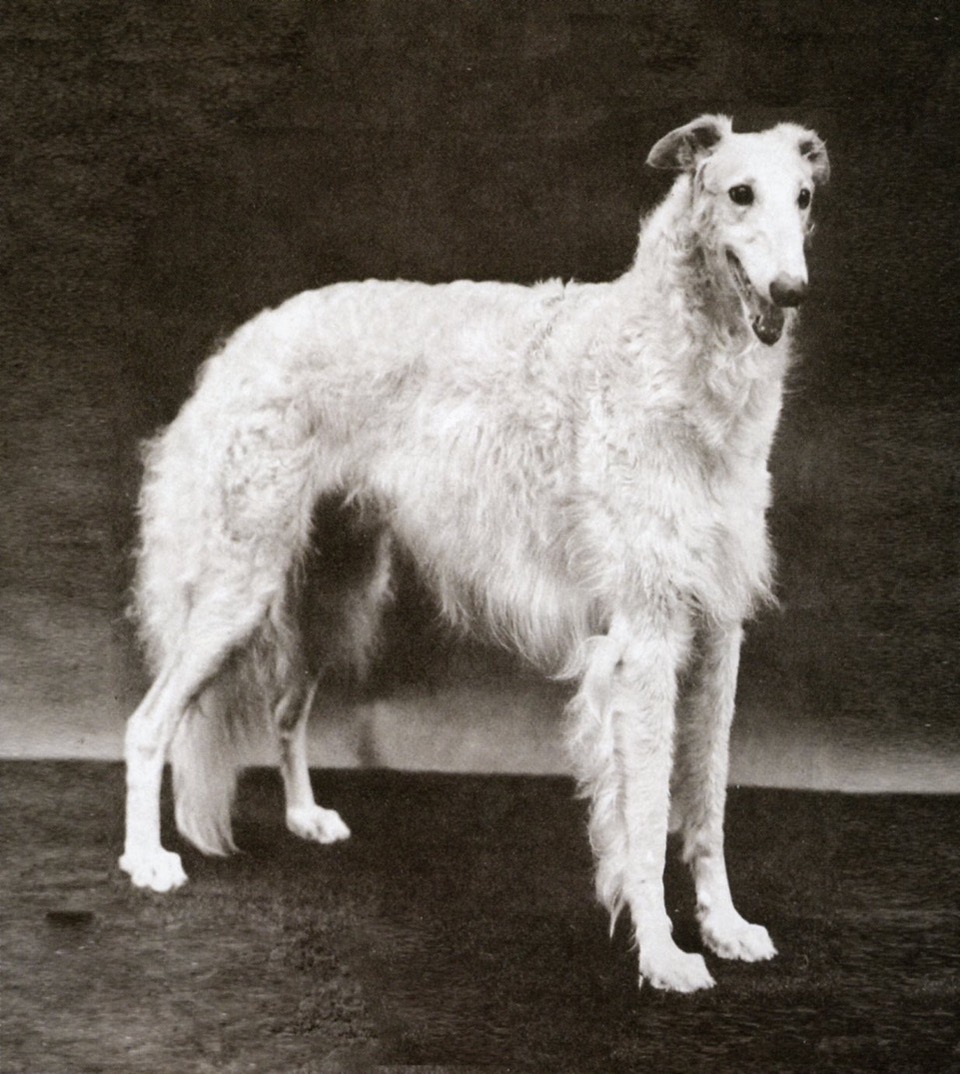
Spoiler alert, a photo of Bo’s hound group winner, in his dream BIS lineup, the great Borzoi Vigow…
Be sure to listen in to catch Bo’s incredible Best in Show lineup representing dogs of yesteryear through present times.
Purchase Bo’s encyclopedic and gorgeous book Best In Show here and visit his fascinating Facebook page of Great Show Dogs of the Past here.
344 – Inspiring True Story: From First Show to Best in Show
Inspiring True Story: From First Show to Best in Show
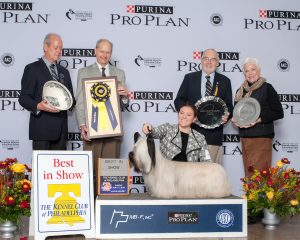
Antoinelle Vulpis and “Archer” winning BIS Sunday at The Kennel Club of Philadelphia.
Antoinelle Vulpis chose a Skye Terrier as her first show dog. Two years after their first show, Vulpis and Archer won Best in Show at The Kennel Club of Philadelphia’s National Dog Show.
Vulpis offers another inspiring “newbie” story as she shares her journey, the importance of her breeders/mentors and the support of the dog show community.
“I grew up like any kid watching Westminster on TV. We had Golden Retrievers as family dogs, but I always kind of wanted something a little different. I was a total dog geek,” Vulpis said.
After college, Vulpis got a job at AKC that required her to attend dog shows.
“I decided I wanted to try this myself. Then I saw Larry Cornelius and Charlie the Skye Terrier. THAT was the dog for me,” Vulpis said.
Parent Clubs and Handlers
Vulpis made contact with Michael Pesare through the Skye Terrier Club of America. She then waited a year for the right dog from the right litter.
Her puppy arrived exactly two years before her first best in show.
“My mentors drove three hours one way without a dog entered just to cheer me on at my first dog show,” Vulpis said. Her breeders helped her learn how to groom the rare breed and supported her at every step, she added.
“My handler friends are so willing to help me and share. They’re the people who inspire me. I try to learn from them,” Vulpis said. “Asking someone more experienced than you will really pay off.”
Vulpis counts professional handlers from Greg Strong to Ernesto Lara in her list of people who have helped her along the way.
Listen to the input
“I asked all kinds of people for advice,” Vulpis said.
Vulpis’ favorite grooming product is #1 All Systems Invisible Hold “It’s the holy grail for keeping the part to stay in place.”
“I don’t brush him every day because it takes hair out. Only once or twice a week to keep mats under control. I keep him clean, and bathe him weekly,” Vulpis noted.
“Now that I’m realizing I can make a difference in how he’s presented and how he looks. I get to the dog show early and spend time bathing his under-carriage and blow dry him. The extra time and care really has paid off,” Vulpis said.
For more stories from new people to the sport, listen here and here.
187 – Reznik Pt. 2: Ad Design Success, Reading & Dreaming
Ad Design Success, Reading & Dreaming
Magazine editor and writer Allan Reznik is back with part two of his fun and helpful interview. His advertising “best practices” tips are outstanding suggestions about when to advertise and how to design a successful ad. His Reading List recommendations are insightful and his Dream BIS lineup is a fascinating stroll through dog show history.
The best uses for advertising, Reznik said, are:
-
Promote a newly recognized or rare breed.
-
Catch judges’ attention.
-
Break through at the group level.
-
Introduce a new dog to the fancy.
-
Launch a dog’s career.
“Judges sometimes need to “give themselves permission” to recognize or acknowledge a dog,” Reznik said. “If that ceiling is broken, other judges will follow suit. … Advertising is going to be, for better or for worse, a successful way to get the dog noticed.”
Reznik added that, when it comes to ad design, “I think some ads are more successful than others. I’m always a believer that less is more.”
Many ad designers, Reznik noted, are young. They forget the age of average judge, which isn’t. “This isn’t Vanity Fair. This isn’t Vogue. The ads can be chic or glamorous, but if you can’t find the name of dog or breeder you’re doing yourself a disservice.”
A candid photo that captures the spirit of the dog and the relationship between dog and handler is always a great idea, Reznik said. “That’s just advertising gold.”
On the other hand, Reznik noted that an ad that quotes the standard alongside the dog is “terribly pretentious. It belittles a judge.”
He also advocated for National Breed clubs to create ads, particularly for new or rare breeds.
“Parent clubs can run a series of ads in which they zero in each month on a detail of a dog,” Reznik said. “I don’t think a single exhibitor should be the one entrusted to educate judges.”
Reznik’s Top Three Favorite Dog Books:
Reznik’s caveat: EVERYONE should own Pat Trotter’s “Born to Win” and Ric Beauchamp’s “Solving the Mysteries of Breed Type.”
Humor – “Dog Eat Dog, A Very Human Book About Dogs and Dog Shows” by Jane and Michael Stern https://www.amazon.com/Dog-Eat-Human-About-Shows/dp/0684838923
Glossy – “The Dog Show” by William F. Stifle. https://www.amazon.com/Dog-Show-125-Years-Westminster/dp/1592282636
Dream BIS lineup
This is a MUST listen to lineup! Reznik puts a lot of thought into the dogs, the owners, and the handlers on this incredible list. Hint: Here are a few pictures. Can you identify the dogs?
And check out Allison Foley’s Tip of the Week from the Leading Edge Dog Show Academy. Whiskers on show dogs: yes or no?

